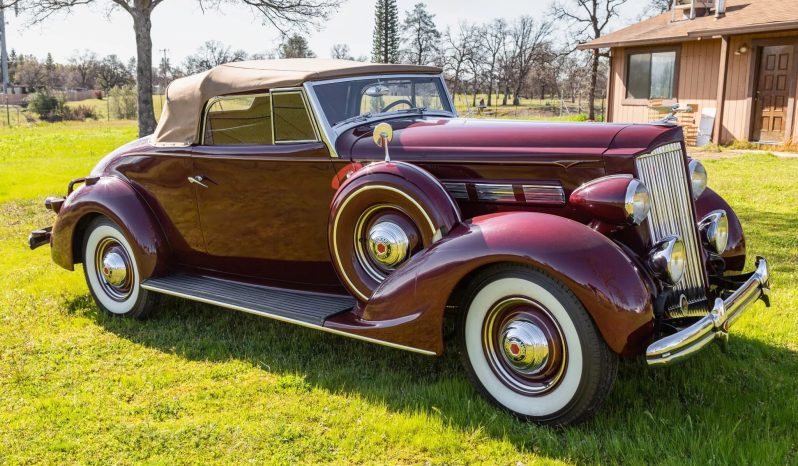This 1937 Packard One Twenty is clothed in convertible coupe bodywork and was delivered new on January 30, 1937. A subsequent recommissioning have included a re-trim of the interior in red leather, a carburetor rebuild, and refreshes of the fuel, ignition, cooling, and brake systems. Finished in burgundy, the car is powered by a 282ci inline-eight mated to a three-speed manual transmission with overdrive. Features include an electric fuel pump, Safe-T-Flex independent front suspension, four-wheel hydraulic drum brakes, a side-mount spare with a body-color metal cover, a fold-down rear luggage rack, a rumble seat, and a beige convertible top.
The 282ci inline-eight features side valves and a single Carter downdraft carburetor and was factory rated at 120 horsepower at 3,800 rpm. Work have included rebuilds of the carburetor, mechanical fuel pump, ignition coil, and water pump as well the addition of an electric fuel pump, a re-core of the radiator, and the installation of a custom-made fuel tank, a transparent coolant filter, and an Optima Red Top six-volt battery. Additional components replaced included the spark plugs, wires, points, condenser, vacuum advance, thermostat, cooling hoses, and fuel lines.
Power is sent to the rear wheels via a three-speed manual transmission that is equipped with synchromesh on its top two gears as well as overdrive. The Safe-T-Flex front suspension comprises upper A-arms mounted to lever-arm hydraulic shock absorbers, wide-angle lower A-arms formed by control and torque arms, and coil springs. The solid-axle rear suspension features leaf springs, lever-arm hydraulic shock absorbers, a lateral stabilizer bar, and an anti-roll bar.
The eight-cylinder One Twenty series joined the Packard lineup in 1935 as a competitor in the mid-price segment and was available in a variety of open and closed configurations on its standard 120-inch wheelbase.
This example’s 1099 convertible coupe coachwork is finished in burgundy with gold pinstriping.
Features include a beige convertible top, a “Goddess of Speed” hood ornament, a windshield-mounted driver-side mirror, a cowl-mounted antenna, a fold-down rear luggage rack, and Trippe driving lights, the latter of which do not work.
The taillight lenses were replaced, and LED bulbs were added to the headlights and taillights.
The body-color 16” steel wheels are accented by gold pinstripes and wear chrome hubcaps and beauty rings.
Coker Classic radial whitewall tires were mounted at each corner, and a removed set of bias-ply tires is included in the sale.
A side-mount spare is housed in a body-color cover that hosts a side-view mirror.
The four-wheel hydraulic drum brakes have been refreshed with replacement of the wheel cylinders, shoes, and springs.
Replacement wheel bearings were also installed.
The cabin was re-trimmed, and features red leather over the bench seat, door panels, and rumble seat.
Replacement color-matched carpeting and floor mats were also fitted overtop heatshield material.
Additional features include roll-up side windows, a floor-mounted shifter, a radio, a cigar lighter, and a locking glovebox with a door-mounted clock.
The turn signal switch have been replaced approximately two months ago.
The brown banjo-spoke steering wheel sits ahead of a burl-woodgrain dash fascia that houses a 100-mph speedometer and rectangular gauges monitoring oil pressure, fuel level, coolant temperature, and amperage.
The five-digit odometer shows 6k miles, TMU.









































